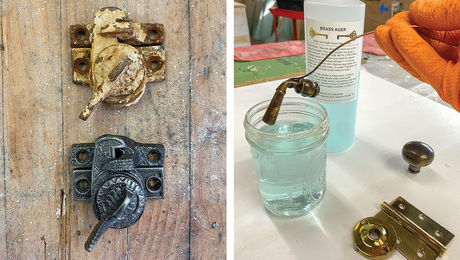*
Hi folks,
I saw a little Q and A in JLC where Mike Byrne, author of Taunton’s “Setting Ceramic Tile”, recommended tooling the grout joints on kitchen counters (not unlike striking mortar joints in brickwork) to make them more impermeable to grunge. This technique was not mentioned in the 1990 printing of his book, which I have used for years as my tile setting reference book.
I tried tooling the joints on a recent project,found it unworkable, and abandoned the effort. Now of course, about a month after setting the countertop, the grout is starting to get grubby looking.
Has anyone ever had success with this?
Steve Zerby


















Replies
*
Steve,
Did you seal the grout joints? What width are the joints, as I'd tend to believe that tooling a narrow joint would be a useless exercise. The normal grout consistency would also make tooling it somewhat like carving warm butter. Maybe Byrne was using a stiffer than normal mix? Recently, I've heard of using an epoxy grout for countertops, and I've also read that it's harder to work with than regular grout and that it can, in fact, be tooled. Interesting topic.
Barry
*Hi Barry,Yes, I used a non-toxic sealer from tec-tile. The kind you just flood over the counter and wipe off the excess.The tiles are handmade 4x4's with joints that are irregular at best, but about 3/16-1/4 inch wide. I used sanded grout because of the larger joints, but not epoxy, as I too had heard that it is quite difficult to use without a helper to clean up right behind you as you go.Steve
*Steve,Really interesting. I can see how one might wish to tool the grout between irregular tiles, as using a float would cover or hide the "reveal," if such a term could be applied to tile. But there seems to still be a stiffness component to be addressed that would facilitate tooling. I can't picture the wet finger approach to an entire field of tile. I have seen pointing tools with diameters down to about 1/4 inch -- did you use such a tool or improvise another?Barry
*Hi Barry,I used a small brick striking tool. I forget the diameter. The main problem was the consistencey of the grout. It was either too crumbly or not firm enough. It never seemed to be just right. Also, with white grout it tended to leave debris in the joint. I have to admit I didn't give it too much of an effort. It seemed impracticle to do the entire field one joint at a time as well. I gave it up after a few swipes and went back to the sponge to shape the joints. Steve